Caution: semi-connected rambling ahead...
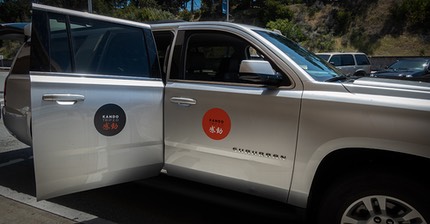
The Urban Dictionary describes “kando” as "one who excels in an activity to a level of such proficiency as to make the opposition and fellow teammates alike appear mentally challenged.” I’m pretty sure that’s not what Sony intends with their use of the word kando.
Indeed, then Sony CEO Kazuo Hirai’s definition was quite different when he presented the term: "Kando translates to mean emotional involvement. The power to stimulate an emotional response. The power to make people say, ‘Wow.' All Sony products must be inspired by a spirit of kando.”
Both definitions was going through my head last week when I attended Kando 2.0, a now annual event that Sony puts on and which has several components to it.
This year’s Kando was held in Monterey, California, at the Asilomar Conference Center to be exact. It was a risky choice, as weather (fog, mist, overcast) is definitely possible, but it appears Sony picked the perfect week, and the California coast line cooperated for pretty much everything on the schedule. And boy, everything was on the schedule.
Sony appears to use Kando as a three-pronged event. Sony employees and managers were first to arrive, and there were activities scheduled around company things. Next came many of the Artisans and some invited guests. Sony employees, a few invited press and pros, and the Artisans interacted, with the Artisans teaching and inspiring the Sony team and others, and vice versa. Finally, there was the last two-and-a-half days, where about 200 selected individuals come for a jam-packed schedule of workshops and shooting opportunities.
Just to give you an idea how diverse the shooting opportunities are at Kando, this year we had: kittens and puppies, food, flowers, time-lapse, landscape, astrophotography, surfing, portraits (including underwater), rock concert, street, long exposure, and a zillion other choices. If you needed gear for something, it was either supplied (e.g. intervalometers and filters for the long exposure workshop) or could be borrowed (camera bodies, lenses, Manfrotto tripods,<tk> lights). Microsoft supplied 30 Surface computers for use, Epson had big printers ready to output what you shot.
Then there was the swag bag (a Manfrotto photo backpack filled with small goodies).
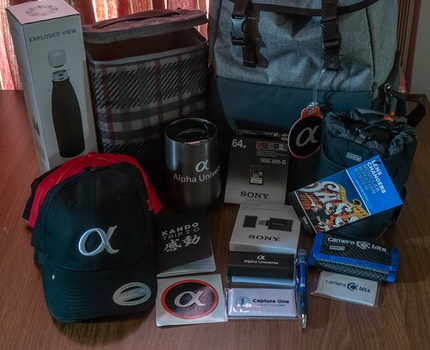
To get into Kando, you have to submit an essay as to why you should be there, and point to a body of work. I did, and I was accepted. But I noticed most of the 150 that were accepted all had very visible and different kinds of Internet presence (not just in photography, but in other disciplines, as well). It seems clear to me that Sony is doing at least some of their selection process based upon how well the things people heard, learned, felt, or experienced at Kando 2.0 would be amplified out into the far reaches of the Web.
That’s a nice touch, though not perfectly executed. I’ll have more to say about that later.
So why did I apply for and end up at Kando 2.0?
I’m perpetually in learning mode. When I saw the initial list of folk presenting, the types of shooting opportunities, the companies that would be there, and the fact that Sony Professional Services would be there with the full set of Sony loaner gear so I could try out a few of the lenses I haven’t yet used, I saw the opportunity to spend some intense time dipping into the Sony universe as I worked on finishing up two Sony camera and a couple of Sony lens reviews, and to maybe learn some new tricks. Oh, and get inspired shooting things I don’t normally shoot.
It’s when I’m around other photographers who are doing different things than I that my brain tends to ignite with new ideas and creativity. And that tends to spill over into my own shooting and teaching in ways that are unpredictable and sometimes surprising.
For instance, upon arriving, for some reason the first thing I ended up doing was get into a long discussion with the Capture One folk. I have to admit that I’ve probably paid less attention to that program than I should have. As we wove deeper and deeper into the product, I was introduced to a feature I didn’t know existed in Capture One. It’s actually not something that looks like much until you consider the workflow implications. Oh, wait, I was supposed to do a lecture on field workflow at B&H the following week. So we deep ended real quick into field workflow and I realized that—at least for macOS users—a trio of products that included Capture One could make a very compelling field workflow that covered all the things that I say a field workflow needs to deal with. Ruh-roh. Time to make some additions and changes to next week’s presentation ;~).
But it got deeper and more creative quickly.
At one point in the discussion, the Capture One demonstrator wanted to show off the grading feature. And he did the thing we all do, all the time, no matter what product we’re using: because the controls are kind of small when docked in the panels, he pulled it off to create a bigger window for the controls.
The first thing that struck me was this: about a quarter of the image we were working on was now blocked from view. Most of that big window that was created was just black background (as in most post processing UI you keep controls/panels in dark mode so that it’s not distracting you from the image).
Aha!
Why not just get rid of all the black and make that big dialog transparent? In essence, go to a HUD (heads up display; the Japanese would call this OSD, or on-screen display) type of use? The grading dialog in Capture One is really just three thin, directly-manipulable circles. Why shouldn’t I be able to center those over the area I want to grade (selection) and manipulate the dials directly over the image? Well, uh, because that’s not the way the designers designed it.
Which led to a discussion of why the Nik U-Point technology was so interesting and useful. You picked a point, the HUD-type display that emanated from that point allowed you to directly manipulate the data within the point’s control. Doesn’t clog up the screen with big dialog boxes/panels.
Technically, you could do this HUD-thing with Levels, Curves, Grading, HSL, a whole host of things we want to manipulate while we’re looking at the image. Just present me the Curve line overlaying the image and let me directly manipulate it. Eezy peezy.
From there I went down to the beach to see what was going on and I started thinking about our cameras. Yeah, HUD exists in the EVF/Live View world. Press the Display button on most cameras to toggle through the Ugly-HUD choices. Most of them are variations of putting lots of icons of current settings over the image area. Even when you bring up a histogram, it’s the full histogram box, and it’s taller than it need be.
What if it were more HUD-like? A wide-but-not-tall histogram that had “tells” at each end to show you that you’ve hit black (0,0,0, or a settable value) or saturation (255,255,255 or a settable value)? The Olympus mirrorless cameras can do this without a histogram, doing a form of peaking display at both ends of the exposure. And of course peaking itself is a form of HUD display, though it doesn’t tell you much about the range of values, just what parts have hit the extreme edge of the exposure capture.
At this point, my mind was racing down the possibilities.
Some of the mirrorless cameras (Canon and Olympus, for example), allow you to drag your thumb on the LCD to position the focus point while you’re looking through the viewfinder. Good first step, but what if I wanted to set focus settings? (Bringing this back to Kando, I had a brand new Sony camera I needed to set up in my hands at the time.)
Well, many of the Sony lenses have this well-positioned lens function button that is naturally right where your left thumb sits. What if I were dragging my right thumb on the LCD to position focus, but if I pressed and held the lens function button I’d immediately get a Focus HUD centered where my thumb was: now move my thumb up to set AF-S/AF-A/AF-C, or left to set AF/MF, or right to set Area Mode, or down to set Eye/Face detect functions. Since the viewfinder is EVF, that would allow me to control all focus operations with two thumbs while looking through the viewfinder and staying ready to shoot.
Now wait, where are the settings on that new A7m3 I was holding that I needed to set for focus? ;~)
After a lot of menu scrolling and trying to remember what the cryptic descriptions/names meant I eventually got my camera set up the way I wanted it. It didn’t help, of course, that I was in bright sunlight and the LCD/EVF are not set by default to be used in such bright light, so I made slow progress to getting everything set right. Of course, by this time at Kando 2.0 I was already half-way through shooting a five-hour music event that had popped up (I told you I was going to ramble).
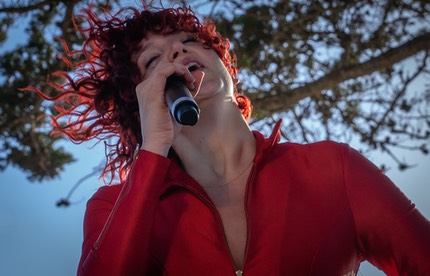
Access to the musicians was so good it was actually more difficult to shoot them. Literally, I could have stuck a camera in their face (see above).
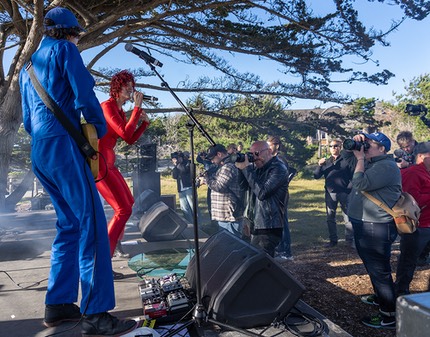
But because the photographers could get so close, it was difficult to actually take a shot of the whole band—actually, there were five bands—because there were so many photographers in front of the musicians!
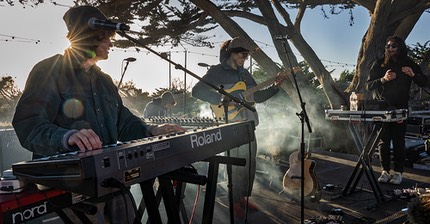
Still, it was good warm-up for me, as I was being stressed in lots of different ways: I haven’t/don’t shoot rock concerts, the sun was setting behind the stage, I had lots of other photographers to watch out for and deal with, and, of course, I had a new camera in my hands that wasn’t even set up yet. So I probably wasn’t going to win any awards for what I shot of the musicians, but still, this was fun and it was beginning to stretch my brain, even though I was just off an all-day, cross-country set of jet rides. Exactly the reason why I wanted to experience Sony Kando.
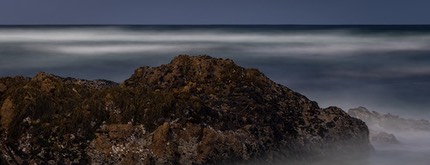
The next day was a smorgasbord of learning and shooting. In the morning Sony Artisan of Imagery Thibault Roland quickly taught us the way he approaches making really long exposure photographs during the day and it was off down to the beach to try to make it work in practice. (As an aside, don’t use variable ND type filters for this, as they are essentially dual polarizers and you get caught in all kinds of issues with edge-to-edge variation in filtration, particularly when you’re shooting wide. Buy a set of dedicated ND filters that can take you down 12 stops or more when used together and it will be oh so much easier. The chart Thibault gave all of us actually goes down to 16 stops, which is what he needs to get those truly long exposures he shoots during the day)
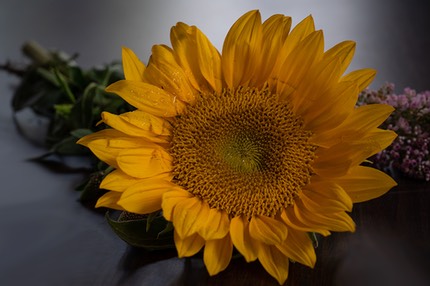
Next up was shooting flowers with Artisan Caroline Jensen. She quickly went through her impromptu handheld style of flower shooting that produces her unique looks, then it was time for us to all go to the Flower Truck—did I mention that Sony was providing everything we needed as subjects?—to pick some flowers to work with and then go off and see what we could get using her techniques and with her advice as we shot.
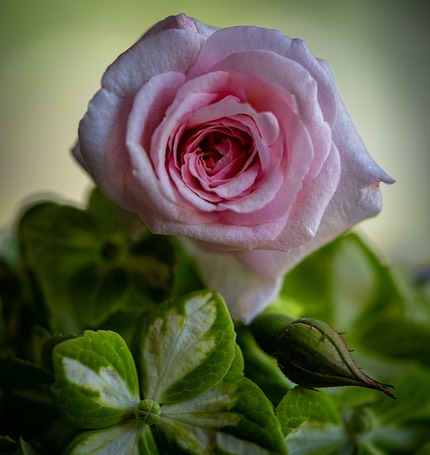
The final shooting experience for me on that first full day was surfing just before sunset. I came to the beach equipped with a peashooter (70-200mm). So I did what any native Northern Californian is not at all averse to doing: I wandered out into the water. Which turned out to be a good choice, as a couple of times it gave me angles that others weren’t getting sitting back from the water with their longer 100-400mm lenses. You'll note in most of these images the surfers are coming down to me. Good thing I grew up in Northern California and dealt with cold water all my life (Pacific Ocean, Tahoe).
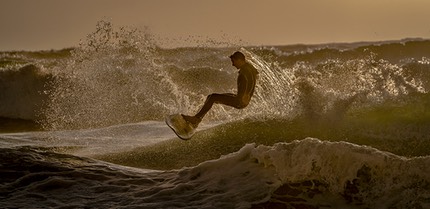
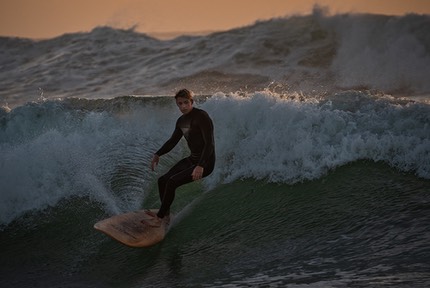
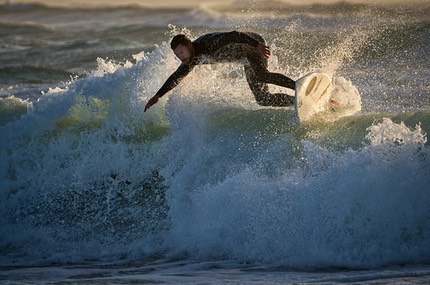
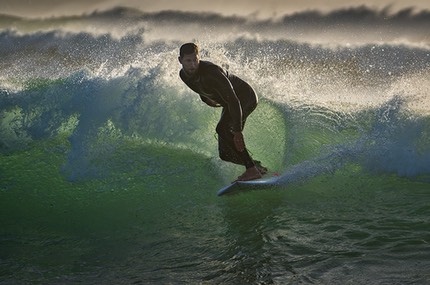
Now, I’m not going to go through everything I shot at Kando. We’d be here all day. But I did want to point out just how diverse the shooting opportunities were. If you want to see what the pros and Artisans were shooting during the week, try this Kando page. Or try this Kando page to see more of what the participants I was with were doing.
Sony was encouraging everyone to post to social media using a Kando hash tag. That’s not my way of sharing an experience (this article is), but it definitely meant that there was a lot of imagery coming out of Asilomar with Sony branding on it. Indeed, most of the gear raffles (read on) were drawn from random selection of those that posted with Kando tags. Thus, I probably wouldn't have posted these images on Instagram to avoid the conflict of interest situation anyway.
That’s not to say that Kando was all about shooting. It wasn’t. There were discussions—for example on photography usage on social media—inspirations (Guy Kawasaki’s keynote address), and even focus groups. And there were giveaways, giveaways, giveaways. Seems like at every meal there were raffles going on with Sony handing out things from plane ride shooting with Chris Burkard to Playstations to Sony A7Rm3’s, plus lots of great lenses and accessories.
I mentioned earlier about the amplification of the event out into the Internet. Curiously, I don’t think that all went as intensely as it could have. The AlphaUniverse Web page was displaying Kandoimagery, and there were all those #SonyKandoTrip hashtags on Instagram and Facebook running around. But this marketing effort felt incomplete to me. You kind of had to know where to go or what to look for if you were going to find the fire hose of images coming out of Monterey from Sony gear. And while some key photo press was here for the second stage of the week before the rest of us arrived, they weren’t amplifying the Kando event as usefully that I could see. Maybe more is coming.
To me, I think Kando needs more connection to the folk who weren’t here. This would be the time to publish Kando tutorials from the Artisans. It would be the time to tie in raffles for people not at Kano on AlphaUniverse. I felt very “engaged” at the event. I’m not sure anyone not at the event felt engaged.
For me everything at Kando seemed to have surprises lurking. It seems like I knew one heck of a lot of people who were here. Old pro photography buddies like Bob Krist and Patrick Racey-Murphy. Some of the key personnel manning the booths at the exhibition. And yes, Guy Kawasaki recognized me from my Silicon Valley days and he immediately challenged me: “I hope you’re still using a Mac” (my software company was one of the ones that Guy had evangelized and got into the Mac developer program before it was announced). And yes, Guy, I am.
Despite all the older folk I knew, the crowd felt distinctly young, energetic, and enthusiastic. There was tons of energy all over Asilomar and throughout Kando 2.0, and interestingly everyone was engaging in conversations with one another as we bustled from one thing to another or sat for meals. The Sony personnel were ubiquitous and gregarious. And that proved to be infectious. Bravo. Every camera company should be as engaging to their customers as Sony was to those of us at Kando.
I’ve been to a lot of company-sponsored events over the years, but Kando 2.0 has to be at or near the top of the list. Fun, fascinating, fervent, festive, and fruitful. We need more of this type of thing happening in photography. It makes you want to create more photos, and more interesting photographs. It makes you want to stretch yourself and your gear to its limits.
So yes, Hirai-san, I had an emotional experience, and “wow” isn’t a bad word for it.
Now, about those small buttons on the cameras...
